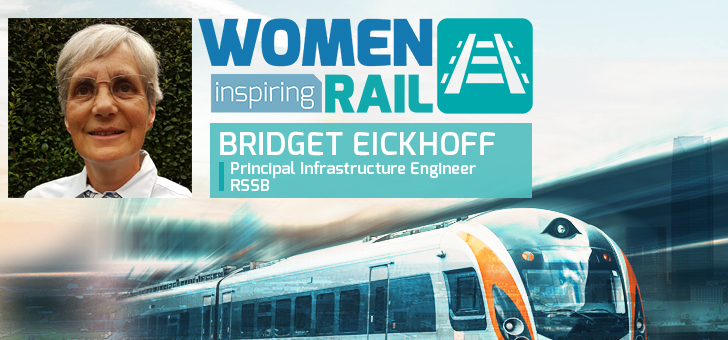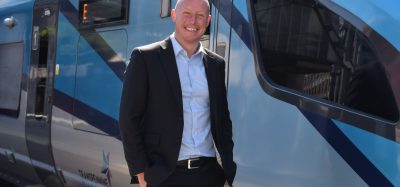Women Inspiring Rail: A Q&A with Bridget Eickhoff, Principal Infrastructure Engineer, RSSB
Posted: 16 August 2019 | Global Railway Review | No comments yet
For our Women Inspiring Rail series, Principal Infrastructure Engineer at the Rail Safety & Standards Board, Bridget Eickhoff, discusses her area of expertise, the rewarding elements of her role and how life in the railway industry is seldom boring.


How did your career in rail begin and what does your current job involve?
I joined British Rail Research as a graduate entrant to the Vehicle Dynamics section to work on developing the understanding of railway vehicle behaviour, track forces, passenger comfort etc. I had a degree in Maths but was successful in getting this engineering job and I have worked as a Mechanical Engineer ever since. It was an exciting time as the developments in computer power meant that the complexity of the models began to match the real world and I was also involved in full-scale on-track testing of a range of vehicles to validate our modelling.
My particular area of expertise is anything around the vehicle-infrastructure interface: this includes the platform-train interface, wheel-rail contact, gauge clearance and understanding the influencing factors for derailments in order to minimise risk.
I stayed with British Rail Research and its successor companies through privatisation until I joined the Rail Safety & Standards Board (RSSB) in 2008. In that time, I was involved in a range of technical areas around the interface of the railway vehicle with the infrastructure. I have also run teams and departments of up to 60 people.
I am now a Principal Infrastructure Engineer at RSSB. My particular area of expertise is anything around the vehicle-infrastructure interface: This includes the platform-train interface, wheel-rail contact, gauge clearance and understanding the influencing factors for derailments in order to minimise risk. I get involved in developing and updating railway technical standards, both GB and international, acting as the RSSB technical lead for a range of research and innovation projects and I am a member of several cross-industry working groups.
What aspects of your job do you find the most challenging/rewarding, and why?
The key for me would be problem solving, whether this is around steering research work in new directions, understanding the issues at the platform-train interface to improve the system for our passengers or developing the most appropriate standards. In all these cases, the first step is to get enough of an understanding of the ‘problem’ to be clear that we are really developing an appropriate solution. People often think of engineering as very technical and largely an individual activity, but most of my work is as part of a team and I need to understand other people’s points of view. Really listening to their input is vital.
It is very rewarding when, with some imaginative thinking, I can help those with apparently conflicting views to come to an agreement (consensus) on a mutually acceptable way forward. Standards can seem a very dry subject but developing the best standards, so that we minimise repeat work and produce an appropriate level of consistency, but without constraining useful innovation, requires a real understanding of the key issues.
One example might be the GB Platform Train Interface Strategy where a cross-industry group of experts in a range of fields all worked together to start to understand and document the issues around the GB mainline platform-train interface. This is the key first stage in making a real improvement for both performance and safety.
What is it about the rail industry that you are most passionate about?
Transport, of people and of goods, is a fundamental requirement of our society and railways are a key part of that. Rail transport is energy efficient, uses less land than roads and is also less polluting. However, we cannot afford to be complacent as other transport modes are continually improving their performance in all these areas and rail must do the same. Hence, there are always new problems to be solved and new technologies to be considered.
The computer modelling methods for railway vehicle dynamics, where I helped with the initial development, are now a routine part of all new vehicle developments and are also widely used in investigating problems in service.
The rail industry, and railway engineering, is also a relatively small field so it is possible for one individual or team to see their own contribution come to fruition. The computer modelling methods for railway vehicle dynamics, where I helped with the initial development, are now a routine part of all new vehicle developments and are also widely used in investigating problems in service.
Britain was one of the railway pioneers, so we have inherited a lot of historic infrastructure; bridges, tunnels, stations, line layouts etc. Making the best possible use of this, whilst adapting it for today’s requirements, is a key challenge.
What has been your biggest achievement/proudest moment so far in your rail career?
I think this would have to be my year as Chairman of the Railway Division of the Institution of Mechanical Engineers. As a maths graduate, with no formal engineering education but encouraged by British Rail Research, I took the route of demonstrating relevant experience to become a member of the IMechE and a Chartered Engineer. The IMechE Railway Division has approximately 5,000 members worldwide and organises a wide range of activities, some at its London headquarters but many around our regional centres. I started attending meetings at the Midlands Centre in Derby, where I was working, and was then asked to become more involved in the local committee, followed by the overall divisional Board. The Chairman is a voluntary role, taking between one and two days a week, nominated from among the senior mechanical engineers in the industry. I was honoured to be asked and RSSB supported me during my year from 2012-2013.
I was also delighted when, with a team of international colleagues, we were awarded the IMechE George Stephenson Gold Medal for a paper that we published following a very successful four-year European Union funded research programme.
How has the rail industry evolved since you joined? What have been the biggest changes?
However much technology advances, people and inter-personal relationships are always essential in successful railway operations.
The biggest change must be in technology. Many of the ideas that were really pushing the boundaries of what was possible when I joined the railway in the late-1970s are now so routine that we don’t even think about it! Communications is one example. When we were running tests trackside our only means of communication was radios over short distances or, for communication with the outside world, a wire connected to a line-side telephone. When we were commissioning the first Wheel Impact Load Detector on the West Coast Main Line south of Glasgow, we got to know the telephone exchange staff very well as we needed to make international calls to the supplier in USA and this was certainly not normal from a line-side phone!
But, however much technology advances, people and inter-personal relationships are always essential in successful railway operations.
Who within the rail community has been an inspiration to you, and why?
My former boss, Cliff Perry, who I worked for when he was Managing Director of AEA Technology Rail, just after privatisation. Cliff is a Chartered Engineer who has worked right across the rail industry and been influential in a wide range of areas. Before I knew him, he had been involved in the introduction into service of the ‘HST’ vehicles and, later, the fitment of their central door locking system to eliminate the safety issues around doors occasionally opening in traffic. He ran the Thameslink train operating company in the run up to privatisation and, after he retired, has continued to be active within IMechE and as a trustee of the Railway Mission.
Cliff was an excellent boss to work for, a very effective leader who recognised that teamwork is essential for any railway project or activity and always credited the contribution of others. Safety is always a top priority, but his approach is pragmatic and practical. I learnt a huge amount from his management style and still enjoy meeting him at IMechE, he is always interesting to talk to.
What can be done to diversify the workforce in the rail sector? What advice would you give to those thinking about pursuing a career in rail?
To anyone thinking about the rail industry as a career I would say ‘go for it’, there are so many varying opportunities and life in the railway industry is seldom boring! Whatever your particular interest you will find something in rail that meets it and the industry will continue to stretch and challenge you.
In my particular area of railway engineering, we have even more of a challenge in terms of diversity than in many other areas. Whilst the range of people involved now is certainly wider than it was when I joined, the gender balance is still not good, and the age profile is worrying.
In my particular area of railway engineering, we have even more of a challenge in terms of diversity than in many other areas. Whilst the range of people involved now is certainly wider than it was when I joined, the gender balance is still not good, and the age profile is worrying. We need more young people from a wider range of backgrounds entering engineering and, specifically, railway engineering. Part of this needs to be tackled at a young age, even in primary school, so that pupils and their parents are aware of the opportunities available and don’t rule themselves out by the subject choices that they make. There are too many young people who, by their GCSE choices, effectively rule out a career in science or engineering. It is possible to change later but it is much harder.
For the rail industry specifically, the IMechE and the other professional institutions, are working hard to highlight the range of options available. Women in Rail and the Young Rail Professionals also do a great job in raising the profile of the industry. The IMechE Railway Division runs the ‘Railway Challenge’ each year for teams of young people studying at University or training in industry. They have to design, build and run a 10 ¼ inch gauge (one fifth scale) locomotive, completing a range of tasks. The competition weekend takes place on the Stapleford Miniature Railway near Melton Mowbray and this year we also welcomed pupils from one of the local primary schools to come and see what was happening. Hopefully some of them, and their teachers, will now have a better idea of what fun railways and railway engineering can be.
If you would like to take part in the Women Inspiring Rail series, or would like to nominate a colleague to part, please email: Craig Waters, Editor, Global Railway Review.







